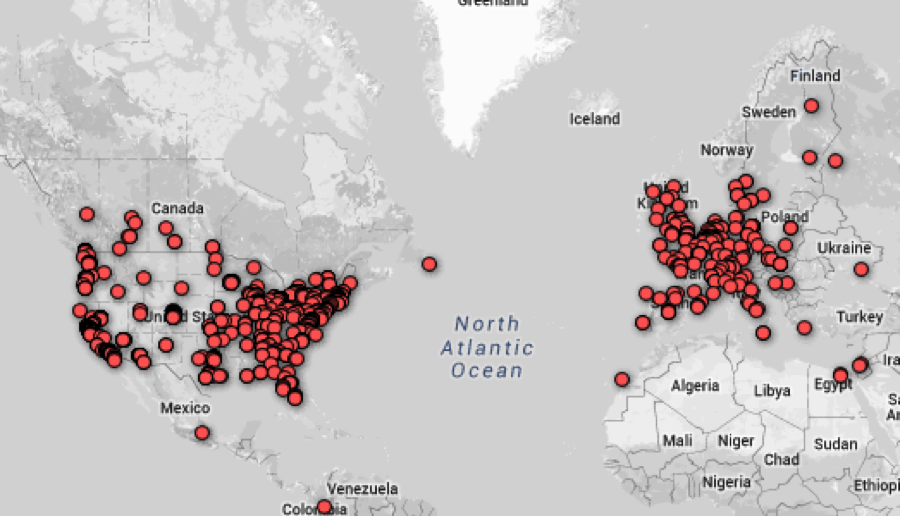Keeping 21st Century Faith in Middle Level Educational Philosophy
There are certain facts and questions that would be useful to serve as foundation for curriculum planning. New ones have emerged since I wrote, The Long View – Curriculum into the 21st Century, for the NC Middle School Journal (2014).
In short, the adult world is awash in the "new oil", digital information, the product of the silent, invisible and endlessly expanding information explosion; information dominates all other forms of capital, and the economy and culture use digital technology to build new businesses and new careers on it every day. Over 80% of the population in the United States uses the Net and the Web every day if not through most of its hours. Such a rapidly changing culture requires inquisitive, question-seeking, self-actualizing edupreneurs. To survive let alone thrive in such a current setting requires a learner centered, student centered educational system that graduates everyone with such skills.
Such thinking has long been central to stated Middle Level educational goals and this is reinforced by elements of the Common Core. These goals are further supported by a new movement that is helping to change community perspective about the value of open-ended project based learning. The makerspace movement (see part of global makerspace map below) has been creating community centers to share 3D printers and other digital fabrication devices for personal projects, and individuals, teams and families have begun to explore their potential.
The longer view then shows multiple forces at work pulling and pushing to build a learner centered question and project focused culture: the adult economy; middle school philosophy; the NC legislature requirement for 2017 to be the year in which all textbooks and instructional materials are digital; 1/3 of state schools (map and discussion) on the march by the fall of 2013 to having a digital device for every student in that (see map above); Common Core making higher order thinking skills a priority; and the new industrial revolution creating a new makerspace explosion on top of the cyberspace explosion still underway.
Against that background it is important to look at the resistance to such change. Have conditions changed in the last decade or if it is still the case that "intelligent inquiry is an illusion at this point in educational practice" (Graesser, Ozuru and Sullin, 1994, p. 122)? The evidence questions our progress: “State and national systems of so-called accountability have had a devastatingly negative effect on student-centered middle school programs” (George, 2014, p.3). Legislative action has treated students as excess labor at a time when we have run out of enough brains to bring in the harvest from the digital information frontier. This is also leading to one more surge to expand the H1B visa program to import talent from other countries. Such argument is being made without equal emphasis on refinancing schools at the level needed. Of equal concern, too many legislatures think finance invents all by itself and are thereby anxious to lower taxes under the theory that this produces jobs. Our state and the nation are left without any evidence that one day we can meet the demands of the digital age with our own citizens.
"We have met the enemy and it is us" (Pogo cartoon). What questions will continue to drive us in the right direction?
George, P. S. (2014). The struggle for middle school in North Carolina: Taking the long view. A speech to commemorate the life and work of John Van Hoose. North Carolina Middle School Journal, 28(1), 1 – 9.
Graesser, A.C., & Person, N.K. (Spring 1994). Question Asking During Tutoring. American Educational Research Journal, 31(1) 104-137.
Shortened Web address for this posting: http://bit.ly/PHAXkH. Hashtags: #50NCMLE14, #makerspace
Twitter: Follow @rshoughton
In short, the adult world is awash in the "new oil", digital information, the product of the silent, invisible and endlessly expanding information explosion; information dominates all other forms of capital, and the economy and culture use digital technology to build new businesses and new careers on it every day. Over 80% of the population in the United States uses the Net and the Web every day if not through most of its hours. Such a rapidly changing culture requires inquisitive, question-seeking, self-actualizing edupreneurs. To survive let alone thrive in such a current setting requires a learner centered, student centered educational system that graduates everyone with such skills.
Such thinking has long been central to stated Middle Level educational goals and this is reinforced by elements of the Common Core. These goals are further supported by a new movement that is helping to change community perspective about the value of open-ended project based learning. The makerspace movement (see part of global makerspace map below) has been creating community centers to share 3D printers and other digital fabrication devices for personal projects, and individuals, teams and families have begun to explore their potential.
The longer view then shows multiple forces at work pulling and pushing to build a learner centered question and project focused culture: the adult economy; middle school philosophy; the NC legislature requirement for 2017 to be the year in which all textbooks and instructional materials are digital; 1/3 of state schools (map and discussion) on the march by the fall of 2013 to having a digital device for every student in that (see map above); Common Core making higher order thinking skills a priority; and the new industrial revolution creating a new makerspace explosion on top of the cyberspace explosion still underway.
Against that background it is important to look at the resistance to such change. Have conditions changed in the last decade or if it is still the case that "intelligent inquiry is an illusion at this point in educational practice" (Graesser, Ozuru and Sullin, 1994, p. 122)? The evidence questions our progress: “State and national systems of so-called accountability have had a devastatingly negative effect on student-centered middle school programs” (George, 2014, p.3). Legislative action has treated students as excess labor at a time when we have run out of enough brains to bring in the harvest from the digital information frontier. This is also leading to one more surge to expand the H1B visa program to import talent from other countries. Such argument is being made without equal emphasis on refinancing schools at the level needed. Of equal concern, too many legislatures think finance invents all by itself and are thereby anxious to lower taxes under the theory that this produces jobs. Our state and the nation are left without any evidence that one day we can meet the demands of the digital age with our own citizens.
"We have met the enemy and it is us" (Pogo cartoon). What questions will continue to drive us in the right direction?
George, P. S. (2014). The struggle for middle school in North Carolina: Taking the long view. A speech to commemorate the life and work of John Van Hoose. North Carolina Middle School Journal, 28(1), 1 – 9.
Graesser, A.C., & Person, N.K. (Spring 1994). Question Asking During Tutoring. American Educational Research Journal, 31(1) 104-137.
Shortened Web address for this posting: http://bit.ly/PHAXkH. Hashtags: #50NCMLE14, #makerspace
Twitter: Follow @rshoughton



Comments